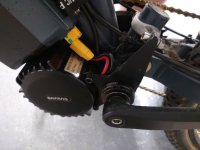Johnny A
1 mW
Thought I'd post this up and say hi.
Build it as a regular bike maybe 10 years ago, just finalising it as an ebike now really.
2004 Iron Horse SGS DH frame with a fox air shock.
Some old Rock Shox 140mm solo air front forks (yes I know this frame is designed for 180+mm dual crown - but they're expensive and I'm poor)
Hope Mono M4 brakes
BBSHD, 42T offset chainring, 33A Daniel Nielson firmware.
52V 12.6ah battery pack made from Molicell P42A 21700s and a Daly BMS (specced to output over 90A continuous should I switch to an aftermarket controller)
Dm03 display
Rear cassette reduced to 3 gears (30T, 24T and 16T) as these are all I need.
I use it for work (9miles and lots of hills) and charge it up in-between. It will do about 16miles with all those hills so I get maybe 3/4 of the way home before it hits low volt cutoff.
So I am charging to 80% at each end now, suits it perfectly. Just completed its first full week of commuting, only issue was a snapped chain link (tbf it's a 10 year old basic chain).
Build it as a regular bike maybe 10 years ago, just finalising it as an ebike now really.
2004 Iron Horse SGS DH frame with a fox air shock.
Some old Rock Shox 140mm solo air front forks (yes I know this frame is designed for 180+mm dual crown - but they're expensive and I'm poor)
Hope Mono M4 brakes
BBSHD, 42T offset chainring, 33A Daniel Nielson firmware.
52V 12.6ah battery pack made from Molicell P42A 21700s and a Daly BMS (specced to output over 90A continuous should I switch to an aftermarket controller)
Dm03 display
Rear cassette reduced to 3 gears (30T, 24T and 16T) as these are all I need.
I use it for work (9miles and lots of hills) and charge it up in-between. It will do about 16miles with all those hills so I get maybe 3/4 of the way home before it hits low volt cutoff.
So I am charging to 80% at each end now, suits it perfectly. Just completed its first full week of commuting, only issue was a snapped chain link (tbf it's a 10 year old basic chain).




